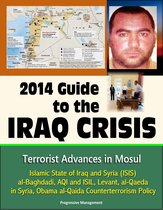The 2005 Iraqi Sunni Awakening: The Role of the Desert Protectors Program - Iraq War and Operation Iraqi Freedom, Anbar, Al Sahawa, Albu-Nimr Tribe in Hit, al-Qaeda Terrorism, Al Qaim, Sheikh Sattar Ebook Tooltip Ebooks kunnen worden gelezen op uw computer en op daarvoor geschikte e-readers.
Afbeeldingen
Sla de afbeeldingen overArtikel vergelijken
- Engels
- E-book
- 9781310597886
- 10 december 2015
- Epub zonder kopieerbeveiliging (DRM)
Samenvatting
Professionally converted for accurate flowing-text e-book format reproduction, this work contends that the Anbar Awakening, as a movement, started 12 months prior to the proclamation in the northwest of Al Anbar, in Al Qaim District along the Syrian/Iraqi border. Most popular narratives of the Awakening in Iraq, the partnering of the Sunni Tribes with the Coalition and Government of Iraq (GOI) to fight al-Qaeda, associate the beginning of the movement with Sheikh Sattar Albu-Risha's 14 September 2006 proclamation in Ramadi, where he coined the term Al Sahawa.
The Albu-Mahal tribe initially sided with al-Qaeda in Iraq (AQI) to fight the Coalition forces. But it soon became apparent that AQI was the real enemy as they implemented their own extreme version of Sharia, Islamic law, and sought to eliminate tribal influence and destroy the social fabric of the province. The Albu-Mahal, in what would become a fight for survival, realized they could not fight AQI on their own and pleaded for help from the Coalition and the GOI. The foundation for developing that partnership was a little known program called the "Desert Protectors." The Desert Protectors were local tribesmen who were recruited, trained, organized, and deployed as scouts under the watchful eye and guidance of the Combined Joint Special Operations Task Force (CJSOTF) in Iraq.
Dr. Knarr tells the story of Al Sahawa, the Awakening, from a different perspective. Rather than the beginning of the movement, the 2006 awakening in Ramadi resulted from an accumulation of efforts; it was part of a sequence of events and local awakenings that started in 2005 in Al Qaim with the employment of the Desert Protectors. Although the Desert Protectors tactical successes were limited, program implications were much greater. Conceptually and creatively, the program was the first GOI and Coalition sanctioned approach linking the use of the tribes for local security to the legitimacy of the national government. Until that time the policy was to work through government institutions; working through the tribes was seen as arming militias. However, Iraqi society had degenerated to such a point that most of the government institutions, especially at the local level, did not exist. The program marked a policy and mindset change in dealing with the tribes that had implications at all levels of war. Although Special Operations Forces (SOF) were central to the start of the program, the involvement of all echelons—Coalition and Iraqi, conventional forces as well as SOF, was critical to bridging the gap between the tactical and strategic. The development of the Desert Protectors on the Awakening movement in 2005 has tremendous lessons for today as a newly formed Coalition organizes to fight the Islamic State of Iraq and the Levant, an outgrowth of AQI. In particular, legitimacy of the government was, and is, critical. That legitimacy is based on the population's belief that the government is looking out for their welfare.
Chapter 1 describes the conditions in Iraq in 2003 and in particular the development of the insurgency, mostly from an Iraqi perspective. Chapter 2 generally describes the year 2004 as a year of chaos and transitions as a new Iraqi Government is installed, the U.S. Embassy is established, and the MNF-I and MNC-I are activated. Chapter 3 takes the reader to the Western Euphrates River Valley (WERV), called Area of Operations (AO) Denver. Chapter 4 focuses on activities in Al Qaim and the Albu-Mahal's uprising against AQI. Chapter 5 discusses the evolution of "engaging the tribes" and the development of the Desert Protectors program. Chapter 6 details SOF's work in the Corridor, primarily in the Hit District, with the Albu-Nimr tribe, one of the most influential Sunni tribes in Iraq. Chapter 7 provides the rest of the Awakening story with events in Ramadi and discusses the relationships among events, suggesting that the movement in Ramadi in 2005 was a missed opportunity.
Productspecificaties
Inhoud
- Taal
- en
- Bindwijze
- E-book
- Oorspronkelijke releasedatum
- 10 december 2015
- Ebook Formaat
- Epub zonder kopieerbeveiliging (DRM)
Betrokkenen
- Hoofdauteur
- Progressive Management
- Hoofduitgeverij
- Smashwords Edition
Lees mogelijkheden
- Lees dit ebook op
- Android (smartphone en tablet) | Kobo e-reader | Desktop (Mac en Windows) | iOS (smartphone en tablet) | Windows (smartphone en tablet)
Overige kenmerken
- Studieboek
- Nee
EAN
- EAN
- 9781310597886
Je vindt dit artikel in
- Categorieën
- Taal
- Engels
- Boek, ebook of luisterboek?
- Ebook
- Beschikbaar in Kobo Plus
- Beschikbaar in Kobo Plus
- Beschikbaarheid
- Leverbaar
Kies gewenste uitvoering
Prijsinformatie en bestellen
De prijs van dit product is 10 euro en 06 cent.- E-book is direct beschikbaar na aankoop
- E-books lezen is voordelig
- Dag en nacht klantenservice
- Veilig betalen
Rapporteer dit artikel
Je wilt melding doen van illegale inhoud over dit artikel:
- Ik wil melding doen als klant
- Ik wil melding doen als autoriteit of trusted flagger
- Ik wil melding doen als partner
- Ik wil melding doen als merkhouder
Geen klant, autoriteit, trusted flagger, merkhouder of partner? Gebruik dan onderstaande link om melding te doen.








